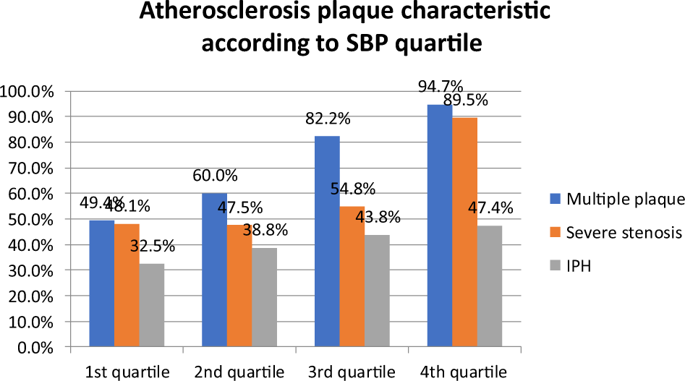当前位置:
X-MOL 学术
›
Hypertens. Res.
›
论文详情
Our official English website, www.x-mol.net, welcomes your feedback! (Note: you will need to create a separate account there.)
Associations between systemic blood pressure parameters and intraplaque hemorrhage in symptomatic intracranial atherosclerosis: a high-resolution MRI-based study
Hypertension Research ( IF 5.4 ) Pub Date : 2020-02-10 , DOI: 10.1038/s41440-020-0411-7 Xiaowei Song 1 , Xihai Zhao 2, 3 , David S Liebeskind 4 , Wendeng Xu 1 , Jun Zhang 1 , Chenming Wei 1 , Yilan Xu 2 , Lixue Wang 2 , Zhuozhao Zheng 2 , Jian Wu 1, 5
Hypertension Research ( IF 5.4 ) Pub Date : 2020-02-10 , DOI: 10.1038/s41440-020-0411-7 Xiaowei Song 1 , Xihai Zhao 2, 3 , David S Liebeskind 4 , Wendeng Xu 1 , Jun Zhang 1 , Chenming Wei 1 , Yilan Xu 2 , Lixue Wang 2 , Zhuozhao Zheng 2 , Jian Wu 1, 5
Affiliation

|
The associations between blood pressure parameters and intracranial vulnerable plaques have not been fully elucidated. The purpose of this study was to investigate the associations between systemic blood pressure parameters, as well as their variability, and intraplaque hemorrhage (IPH) in stroke patients with intracranial atherosclerosis. We retrospectively analyzed the high-resolution MRI data set of intracranial atherosclerosis from a comprehensive stroke center. The atherosclerotic plaque burden and presence of IPH in each vessel were obtained from vessel wall imaging. Blood pressure parameters in the first week of admission were used. The systolic blood pressure (SBP), diastolic blood pressure (DBP), pulse pressure (PP), and their variability (standard deviation [SD] and coefficient of variation [CV]) were compared between the IPH (+) and IPH (−) groups. Logistic regression analysis was used to demonstrate the correlations between different blood pressure parameters and IPH. The results indicated that SBP and PP were associated with multiple plaques and severe luminal stenosis after adjusting for confounders, with OR = 1.071, 95% CI: (1.044–1.098) and OR = 1.039, 95% CI: (1.019–1.060) for SBP and OR = 1.058, 95% CI: (1.027–1.089) and OR = 1.044, 95% CI: (1.019–1.070) for PP, respectively. SBP was associated with IPH after adjusting for cardiovascular risk factors, with OR = 1.021, 95% CI: (1.003–1.038), but not after correcting for plaque burden, with OR = 1.014, 95% CI: (0.996–1.032). No associations between blood pressure variability and atherosclerotic plaque burden or IPH were detected in this study. In conclusion, SBP is associated with IPH after adjusting for cardiovascular risk factors but not after further correction for atherosclerotic plaque burden. The association between blood pressure variability and intracranial atherosclerosis requires further study.
中文翻译:

全身血压参数与症状性颅内动脉粥样硬化斑块内出血之间的关联:一项基于高分辨率 MRI 的研究
血压参数与颅内易损斑块之间的关联尚未完全阐明。本研究的目的是调查全身血压参数及其变异性与颅内动脉粥样硬化脑卒中患者斑块内出血 (IPH) 之间的关联。我们回顾性分析了来自综合性卒中中心的颅内动脉粥样硬化的高分辨率 MRI 数据集。从血管壁成像中获得动脉粥样硬化斑块负荷和每个血管中 IPH 的存在。使用入院第一周的血压参数。收缩压(SBP)、舒张压(DBP)、脉压(PP)、并在 IPH (+) 和 IPH (-) 组之间比较了它们的变异性(标准偏差 [SD] 和变异系数 [CV])。Logistic回归分析用于证明不同血压参数与IPH之间的相关性。结果表明,在调整混杂因素后,SBP 和 PP 与多斑块和严重管腔狭窄相关,OR = 1.071, 95% CI: (1.044–1.098) 和 OR = 1.039, 95% CI: (1.019–1.060) PP 的 SBP 和 OR = 1.058, 95% CI:(1.027–1.089) 和 OR = 1.044, 95% CI: (1.019–1.070)。在调整心血管危险因素后,SBP 与 IPH 相关,OR = 1.021,95% CI:(1.003–1.038),但在校正斑块负荷后则不相关,OR = 1.014,95% CI:(0.996–1.032)。本研究未检测到血压变异性与动脉粥样硬化斑块负荷或 IPH 之间存在关联。总之,在调整心血管危险因素后,SBP 与 IPH 相关,但在进一步校正动脉粥样硬化斑块负荷后,SBP 与 IPH 相关。血压变异性与颅内动脉粥样硬化之间的关联需要进一步研究。
更新日期:2020-02-10
中文翻译:

全身血压参数与症状性颅内动脉粥样硬化斑块内出血之间的关联:一项基于高分辨率 MRI 的研究
血压参数与颅内易损斑块之间的关联尚未完全阐明。本研究的目的是调查全身血压参数及其变异性与颅内动脉粥样硬化脑卒中患者斑块内出血 (IPH) 之间的关联。我们回顾性分析了来自综合性卒中中心的颅内动脉粥样硬化的高分辨率 MRI 数据集。从血管壁成像中获得动脉粥样硬化斑块负荷和每个血管中 IPH 的存在。使用入院第一周的血压参数。收缩压(SBP)、舒张压(DBP)、脉压(PP)、并在 IPH (+) 和 IPH (-) 组之间比较了它们的变异性(标准偏差 [SD] 和变异系数 [CV])。Logistic回归分析用于证明不同血压参数与IPH之间的相关性。结果表明,在调整混杂因素后,SBP 和 PP 与多斑块和严重管腔狭窄相关,OR = 1.071, 95% CI: (1.044–1.098) 和 OR = 1.039, 95% CI: (1.019–1.060) PP 的 SBP 和 OR = 1.058, 95% CI:(1.027–1.089) 和 OR = 1.044, 95% CI: (1.019–1.070)。在调整心血管危险因素后,SBP 与 IPH 相关,OR = 1.021,95% CI:(1.003–1.038),但在校正斑块负荷后则不相关,OR = 1.014,95% CI:(0.996–1.032)。本研究未检测到血压变异性与动脉粥样硬化斑块负荷或 IPH 之间存在关联。总之,在调整心血管危险因素后,SBP 与 IPH 相关,但在进一步校正动脉粥样硬化斑块负荷后,SBP 与 IPH 相关。血压变异性与颅内动脉粥样硬化之间的关联需要进一步研究。


























 京公网安备 11010802027423号
京公网安备 11010802027423号